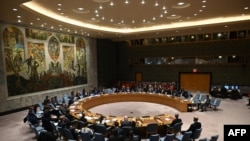One hundred days after U.N. Secretary-General Antonio Guterres’ call for a global cease-fire to support the COVID-19 response, the U.N. Security Council has overcome objections of two powers to unanimously adopt a resolution supporting the truce.
“The negotiations were not easy, but this resolution shows that differences can indeed be overcome – especially in the face of this pandemic,” the council president, German Ambassador Christoph Heusgen, told members on Wednesday.
On March 23, as the virus was ravaging parts of Asia, Europe and North America, the U.N. chief called on warring parties to silence their guns to create space for medical professionals and aid workers to combat the pandemic.
“The fury of the virus illustrates the folly of war,” Guterres said in calling for the global cease-fire. “It is time to put armed conflict on lockdown and focus together on the true fight of our lives.”
Many nations and armed groups responded positively to the call, although implementation has been spotty at best, and in a few war-torn countries, fighting has even escalated.
At the time of the U.N. chief’s call, there were some 350,000 confirmed cases of COVID-19 worldwide and more than 15,000 deaths. COVID-19 is the disease caused by the novel coronavirus, which continues to spread to new regions. Today, there are more than 10.5 million confirmed cases and a half-million deaths.
In the Security Council, which has been plagued by divisions over how to handle some conflicts, what should have been a straightforward adoption became bogged down in the deterioration of relations between the United States and China over the origin and spread of the infection.
“China and the U.S. embarrassed themselves and hurt the council by squabbling over whether the resolution should refer to the World Health Organization (WHO), rather than taking a unified stance on COVID-19,” said Richard Gowan, U.N. director for the International Crisis Group.
“Regrettably, the council’s action has been seriously delayed by the U.S. unilateral stance and deliberate creation of obstacles,” China’s U.N. mission said in a statement following the adoption.
In the statement submitted with its vote, the United States said it generally supported the resolution but that it lacked “critical language” emphasizing the importance of transparency and data-sharing in fighting the virus and expressed this concern during the negotiation process.
“Throughout our engagement in fighting the spread of this pandemic, we have consistently emphasized the need for complete transparency, objectivity, and the timely sharing of public health data and information with the international community,” the U.S. mission said. “We have also stressed the importance of collecting accurate, science-based data and analyzing the origins, characteristics, and spread of the virus.”
France and Tunisia drafted the text and did not give up on negotiations. The WHO is not mentioned in the final document, but a reference to a General Assembly resolution that does include the organization is, as well as noting the United Nations is “playing a key coordinating role” in the global response.
“This resolution is setting clear priorities: a cessation of hostilities, a humanitarian pause and solidarity to face the COVID-19 pandemic,” said France’s envoy Nicolas de Riviere. The humanitarian pause is to last at least 90 days.
Gowan said the council missed its best chance to give the secretary-general’s cease-fire extra momentum in April and May.
“I am not sure the resolution will have much impact now, but council members should use some diplomatic muscle to push for specific cease-fires in countries like Yemen and Libya to show this resolution is not just a public relations exercise,” he said.








